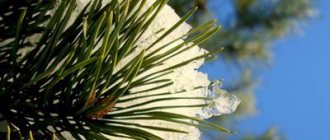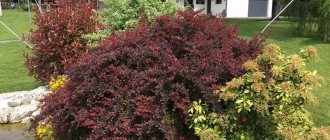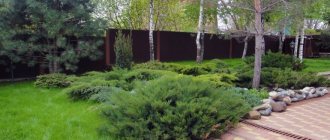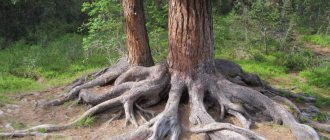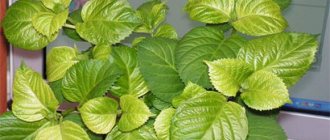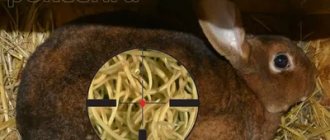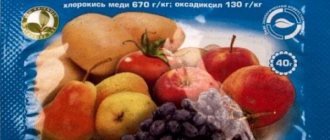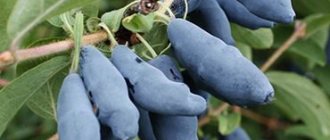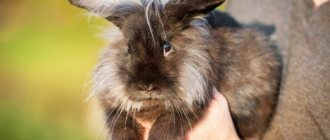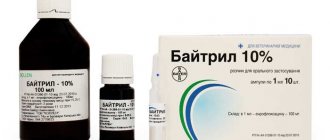Features of life of coniferous species
Conifers are unpretentious plants; they do not require sufficient moisture, light, or heat. Feeding performs an exceptional function - tree growth. But at the same time, gardeners need to remember about their characteristics and sensitivity to chemical and organic fertilizers. It is known that they do not tolerate large amounts of nitrogen substances in the soil, reacting to it with chlorosis or the death of individual parts. The needles are not very sensitive to photosynthesis, so they constantly need liming of the soil (it is better to use dolomite flour). It should also be remembered that the soil should contain as many microelements as possible, such as potassium, phosphorus, magnesium, etc.
Coniferous trees in autumn
Undoubtedly, many gardeners and hobbyists note the high popularity of unpretentious and beloved coniferous trees and plants. Not only do they remain a decorative addition to your garden year-round, but conifers come in a variety of shapes and colors and are easy to care for.
Coniferous trees in the fall look very good in compositions with other trees in the garden, but autumn is the time when you can worry about your “evergreen friends”.
Firstly, coniferous trees may need sufficient watering in the fall. Most coniferous plantations (for example, spruce) have a large and dense crown, which makes them poorly permeable to moisture. Sometimes, despite heavy rain, the ground under the spruce may be completely dry.
Therefore, especially if the autumn turned out to be dry and not rainy, you should ensure sufficient watering, because coniferous plants evaporate moisture before frost and may subsequently suffer from drought and burns.
During winter thaws or spring warming, conifers actively evaporate moisture, while their roots may still be in frozen soil, which prevents the plant from replenishing moisture. Worry about this in advance, before the onset of cold weather (October-November).
Secondly, coniferous trees in the fall need protection from pests such as fungal diseases and parasitic insects. Such pests can weaken the plant before the onset of winter and cold weather. That is why at the end of summer and at the very beginning of autumn you should not neglect specialized preparations that protect coniferous plantings.
However, fertilizing with nitrogen-containing fertilizers, as well as treating coniferous plants with biostimulants should be stopped before the onset of autumn (at best, before August). Otherwise, the young shoots will actively continue to grow and will not have time to grow stronger or ripen before the onset of cold weather.
The roots of coniferous trees can be watered (strictly at the root) with a solution that stimulates root formation. This procedure will ensure better development of the root system before the onset of cold weather and winter frosts. You can mulch the tree trunk circles with some organic material, which is especially useful and important for young plantings.
The mulch material should be loose and at least five centimeters thick, then it will protect the roots from severe frosts. In spring, the mulch should be removed to avoid damping off and allow the soil to quickly warm up.
Thirdly, autumn haircut. Although pruning of coniferous trees in temperate latitudes begins in early spring and ends in late autumn, please note that each coniferous planting has its own periods of active growth, accompanied by abundant release of resin. You should not disturb the plants during this period, the intensity of which most often falls in early spring and summer.
As a result, autumn is the most attractive time for cutting and pruning, especially for beginners. But in plants such as larch, cypress, and thuja, in the fall it is advisable to trim off all broken, yellowed and diseased parts of the branches.
If you trim coniferous trees in the fall, do not throw away the trimmed branches. The cut branches of the spruce will make a beautiful “spruce branches”. This material will serve as an excellent shelter for plants during cold periods.
How
In order for the treatment of coniferous plants to be effective and achieve maximum results, it must be carried out correctly. Sometimes even the most expensive product, which everyone praises, turns out to be completely useless only because it was applied without following certain rules. Before you go and spray plants, you need to learn how to do this.
First, you need to clearly understand the purpose of the processing. Why are you going to do it? As we have already found out, it can be preventive, therapeutic or restorative. In this regard, a specific drug is selected. When choosing it, rely on the advice of experts. It must solve two problems: help achieve results and be intended for external spraying of coniferous plants (not fruit, not flowering, not garden, but coniferous).
Secondly, you need to carefully study the instructions for the chosen drug. In terms of proportions and protective measures, it must be strictly observed. If biostimulants are most often produced on a natural basis and are completely harmless, then fungicides and insecticides can be quite dangerous to human and animal health - especially to the skin and lungs. Therefore, there must be extreme caution. Re-read the prescription of the drug. Not all of them have a wide spectrum of action. You won't be able to get rid of a bark beetle if the instructions say it's an aphid repellent.
Thirdly, you will need special equipment and clothing:
- protective glasses;
- protective face mask / respirator / multi-layer gauze bandage;
- thick gloves;
- rubber boots;
- special protective rubberized suit;
- headdress;
- a spray gun with nozzles / piston-type pump or compressor.
A spray container often comes complete with preparations for treatment, but not always. Its size depends on the height of the conifer. Ornamental varieties, ground cover plants, yew, juniper, small bushes can be sprayed with a regular spray bottle. For spruce, pine, cedar, cypress trees, alleys and hedges, more complex and voluminous structures are needed, and the jet of the sprayed product rises 2-3 m upward to spray the entire crown, and not just the bottom.
Fourthly, when processing you should try to follow the following recommendations:
- If it is possible not to mix two drugs (even if they are different in their functionality), do not do it.
- Dilute the product exclusively in the proportions specified in the instructions for it.
- Shake the spray bottle thoroughly several times before spraying.
- Conifers are processed at a distance of 0.5-1 m. Make sure that the jet reaches the tree (shrub).
- First, the trunk itself is processed from top to bottom, then the branches that make up the inner layer of the crown, and only lastly the outer needles.
- You should not miss a single area where fungal spores or insect eggs may remain.
- At the end of spraying, the root area with a radius of 1-1.5 m should be treated, because fungi and insects may also be present on it.
- The same applies to neighboring plants that are found very close to conifers.
- Upon completion of work, thoroughly rinse the spraying device.
- Wash your hands and face with antibacterial soap, take a shower, and rinse your mouth.
Fifthly, if there is a need for complex processing, when you need to mix two drugs and prepare one solution based on them, use the compatibility tables. Fungicides are designated by the letter “f”, insecticides by “i”.
Features of caring for conifers in the fall and preparing for winter - general tips
Every gardener knows how to prepare conifers for winter. Autumn fertilizing is necessary to prepare plants for wintering. For this, there are folk methods or remedies that can be purchased in special stores. The best fertilizer for evergreen shrubs and trees is mineral fertilizers. Vermicompost and compost, according to experienced gardeners, are considered the best options.
Among industrial fertilizers, preference should be given to those containing large amounts of magnesium. With its help, the needles retain their color and do not fall off. Conifers cannot be fed with manure, like fruit trees in a garden, as this can cause burns. To maintain the quality of trees, you need to know how to care for them, purchase high-quality fertilizers and carry out all activities (feeding, watering, pruning) in a timely manner.
This is interesting: Planting and caring for calla flowers at home: growing in a pot
Work time
Plants require attention year-round. Autumn care is a busy time for gardeners. How productively the seasonal preparation of trees is carried out determines how they will survive the winter. They are treated for pests, weeds are removed, fertilizing is applied, and they are treated for diseases. Root feeding of young trees is especially important to help them survive the cold.
Caring for conifers in the fall includes several types of work using various materials and solutions against pests and frost. The use of industrial fertilizers requires strict adherence to the instructions for use. A shallow hole is dug around the trunk and a nutrient solution is poured into it. If granular fertilizers are used, they must be sprinkled on top with a small layer of soil.
What is the difference between fertilizing conifers and ordinary trees?
Suitable fertilizers for evergreens do not contain nitrogen. This microelement is also necessary for conifers, as well as for deciduous crops, but in minimal reserves. And needle-shaped nitrogen is extracted directly from the air.
Important. Nitrogen, as an aggressive substance, burns the root system of evergreen plants.
An excess of nitrogenous substances in feeding coniferous thuja and juniper plants also leads to abnormal growth of branches. Because of this, they cannot become lignified before the onset of the cold period. This leads to freezing of the tops and death of the crop.
Protect from snow and sun
In such representatives of conifers as thuja and juniper, due to the vicissitudes of the weather (wet snow, freezing rain), the branches fall apart in different directions, which can lead to their breaking off.
To avoid this, it is necessary to wrap the crops with a shading net. In addition to the fact that it allows you to maintain the shape of the plant, it also acts as good protection from the spring sun.
Covering material is not of any help to us here, since the conifers under it can dry out.
This is all. These are the simple manipulations that need to be done to prepare our crops for the winter.
Video: How to prepare conifers for winter.
Preparing for winter
It is necessary to prepare conifers for the cold season in advance. In the fall, they are thoroughly watered (up to 9 buckets for each plant), young trees are mulched with tree bark, and fertilizers are applied. Some gardeners prefer to feed conifers in the fall with rotted compost (cover the plants with a layer of 5 cm), others use special purchased fertilizers.
Trimmed conifers are covered for the winter. This is done after abundant watering and fertilizing. During the cold season, plants will not be able to receive adequate nutrition, and therefore they must make the necessary reserves in the fall. The main thing is to follow the dosage and not “overfeed” the coniferous trees.
These trees really need magnesium. It is this element that is responsible for the integrity of the needles. With a deficiency of magnesium, the needles turn brown, dry out and fall off. This is most pronounced during the dry period. To compensate for the deficiency of this microelement, it is better to use liquid mineral complexes specifically designed for coniferous trees.
What compounds can harm evergreens?
When choosing autumn fertilizer for coniferous trees, some gardeners prefer superphosphate for the large amount of phosphorus in its composition, which improves plant immunity and preserves the color of needles, but this fertilizer is often sold as part of a fertilizer mixture containing a nitrogen component. Therefore, it is preferable to choose special compositions for pine, fir and spruce, which contain a balanced complex of magnesium, potassium and phosphorus without nitrogen.
In their natural environment, spruce and pine trees can withstand Siberian frosts down to -65 degrees, since they are not fertilized and do not violate natural immunity. Therefore, in the countryside, pine and fir trees cannot be fertilized with manure, even if the mullein is well diluted with water. In addition to the fact that such fertilizing for coniferous trees can destroy the plant by damaging its root system, nitrogen stimulates the vigorous growth of greenery, which will not have time to become lignified before winter, as a result of which the tops will freeze.
Why you can’t fertilize conifers with manure, and what can replace it
It is not recommended to feed conifers with manure, as it can burn the entire root system of young plants and significantly damage the roots of adults. The whole point is the high nitrogen content, which has a detrimental effect on the growth and development of coniferous plants.
Manure can only be used in the form of humus that is more than three years old. It is enough to lightly sprinkle the soil around coniferous plants with this dry humus. Moreover, if the branches turn yellow or brown, the top layer of soil (with humus) must be removed, and instead, a mixture of earth and sand should be poured. After this, it is recommended to increase watering: this should help flush out from the soil any remaining substances that have a negative effect on the plant.
Why is nitrogen dangerous for conifers?
A high concentration of nitrogen in the soil promotes the formation of new shoots, which do not always have time to grow by winter, which is why they die during the cold period. And the shoots that survived the winter become very sick in the spring and summer, which also has a detrimental effect on the growth of coniferous plants.
The very formation of shoots in such conditions and the subsequent struggle for their survival takes too much energy from conifers. Therefore, mineral fertilizers, vermicompost and compost are most suitable for feeding these plants.
When planting and mulching, peat, leaf humus, and complex compost are used. Thanks to them, plants receive nitrogen, phosphorus and potassium in the optimal quantity and form.
Which substances will bring the greatest benefit?
As mentioned above, for normal photosynthesis, fertilizer for coniferous trees in the spring must contain magnesium. Dolomite flour can be used as its source in a dosage of about 1 kg per 1 trunk. In acidic soils, calcium deficiency is possible, although the tree needs it only in the spring, when shoots grow. Therefore, the fertilizer must contain a certain amount of calcium in a highly digestible form. In addition to the above, you will need formulations with iron and sulfur. As a rule, they are found in complex fertilizers, like potassium humate, Fertika Vesna, etc.
Foliar fertilizing for coniferous plants is carried out with vermicompost. The substance contains beneficial microorganisms and biological compounds, increases soil fertility and saturates plants with the most important elements. This feeding increases the endurance of conifers and resistance to diseases.
It is useful to fertilize the soil with compost. It’s not difficult to prepare it yourself - household food waste, tops and weeds from the beds will be used. During fermentation, vermicompost or “Baikal EM-1” is added to the compost. Compared to manure, compost contains almost no nitrogen. The fertilizer is spread in a 3 cm layer in tree trunk circles and mixed with the soil using a rake.
This is interesting: Adenium at home - growing, care, reproduction, transplanting
Mineral fertilizers for coniferous plants
Of the mineral substances, conifers prefer magnesium, which is similar in structure to chlorophyll and is necessary for photosynthesis of needles. Therefore, it is recommended to fertilize with dolomite flour (0.5-1 kg per tree), which contains the most optimal amount of magnesium for needles.
Many conifers grow in acidic soils that have very little free calcium. Plants especially need this element in early spring, when young shoots grow. Therefore, for spring fertilizing, you should choose fertilizers that contain a small amount of digestible calcium.
Coniferous plants also have a high need for sulfur and iron. They and other elements are contained, for example, in mineral fertilizers Fertika Vesna for evergreens, Pocon Long-term fertilizer for conifers, Potassium Humate, etc.
When buying fertilizer in a store, check the composition. Complex fertilizers must contain a sufficient amount of microelements, because If they are deficient, coniferous trees may develop chlorosis - whitening or browning of needles.
The benefits of vermicompost
Vermicompost is used in liquid form for root feeding of coniferous plants. It is diluted with water according to the instructions and watered over the plants. Vermicompost is good because it contains biological compounds and beneficial microorganisms available to plants.
When it is added to the soil, its fertility increases significantly, and plants receive all the nutrients they need. Conifers become more hardy, their resistance to diseases and other adverse factors increases.
Feeding coniferous plants with compost
One of the most accessible fertilizers for conifers is compost. You can easily prepare it yourself from what is on the site: weeds, tops, organic waste. In addition, vermicompost can be added to the compost at the fermentation stage (this will help populate beneficial microflora) or the Baikal EM-1 preparation.
Compost, unlike humus, does not contain a large amount of nitrogen, but it contains a full range of minerals and trace elements necessary for healthy plant growth. The finished compost should be spread in the tree trunks of coniferous plants in a layer of 3 cm, then mixed with the top layer of soil using a rake.
When and what to feed coniferous plants
Coniferous plants, depending on the type and size, are fed mainly in spring and summer. But it is also possible to fertilize them in the fall.
How to feed conifers in spring
Applying fertilizer to the tree trunk of coniferous plants
Coniferous plants are fed in early spring, as soon as the snow melts and the top layer of soil looks slightly dry. If fertilizing is carried out with slow-acting fertilizer (compost), then only one such procedure is sufficient.
If the needles of plants have turned yellow after winter, it is recommended to water them with Zircon (1 ml per 10 liters of water) and spray them with Ferovit (5 ml per 10 liters of water). Four such procedures should be carried out with an interval of 10 days. If the needles have darkened and crumbled, then to restore them, the plant is treated all summer according to the same principle, only Ferovit can be replaced with Siliplant.
How to feed conifers in summer
Biohumus and mineral fertilizers can be applied twice: in spring (usually in April, when night frosts have passed) and in June - early July or August. These are so-called maintenance feedings.
From the end of spring to the end of summer (and in the southern regions also at the beginning of September), small liquid fertilizing and spraying twice a month are useful. Fertilizers such as Agricola, Fertika Leto for evergreens, Bona Forte (liquid), etc. are suitable for these purposes. The powder or concentrate is diluted in water according to the instructions.
How to feed conifers in the fall
Fertilization in late summer or early fall should be completed at least a month before the first frost. It is not recommended to feed coniferous plants later, because their new, non-lignified shoots may freeze in winter.
It is better to underfeed coniferous plants than to overfeed them. And under no circumstances should nitrogen be used, especially in the second half of summer.
In autumn, conifers can be fed only with superphosphate or special autumn fertilizers for conifers, for example, Florovit with the appropriate marking. Dry fertilizers are applied under digging or scattered in the tree trunks of plants and watered. This feeding of conifers is not dangerous due to the fact that phosphorus becomes available to the root system only in the spring.
Following these simple rules will help you grow healthy evergreen trees and shrubs with beautiful needles on your site.
Classifications
To choose the right fertilizer for coniferous crops, you need to understand how the fertilizer system works. There are different classifications based on various criteria. Figure out which ones are most important to you.
Store-bought - natural
You can buy ready-made fertilizers for coniferous trees in the store. Their advantages: highly effective, designed specifically for the requirements of certain breeds, accompanied by detailed instructions on when to feed, how and with what to breed.
You can use homemade ones prepared with your own hands from:
- rye bread;
- medicinal herbs;
- bird droppings;
- manure;
- turf land;
- complex compost;
- leaf humus;
- peat
The advantages of homemade fertilizers are that they do not require significant financial costs and have a natural composition. However, it is impossible to say for sure how effective they will be against this or that conifer. And it’s easy to make a mistake with proportions, which can result in the death of a tree or shrub.
Specific and universal
In the store you can buy fertilizer marked “for conifers”, “needles”, “for evergreens”, etc. This means that these preparations are intended for feeding these particular tree species. But there are also a number of useful nutrient mixtures that are used for any garden crops.
Ammophos
Popularly known as ammophoska. This is a nitrogen-phosphorus concentrate in the form of granules or powder. Provides conifers with a sufficient amount of phosphates, promoting intensive growth of the root system.
Nitrophoska
Complex universal fertilizer made of nitrogen, phosphorus and potassium (the so-called NPK complex). It is produced in the form of easily soluble granules that break down into ions in the soil and are quickly absorbed by the root system. The main goal is to improve the quality of the soil, for which conifers have quite high demands.
Ammonium nitrate
Other names: ammonium nitrate, ammonium nitrate, ammonium salt of nitric acid. Universal mineral nitrogen fertilizer. Available in the form of instant granules. It is especially useful for coniferous plants in that it promotes the formation of chlorophyll, which is necessary for the bright and rich color of foliage.
Gardeners should know that ammonium nitrate and urea, although similar, are not the same thing. In the first, the nitrogen content is 34%, in the second - 46.63%. Their choice depends on the nature of the soil. For example, if conifers grow on light acidic soils (sandstone or sandy loam), then carbamide (urea) is recommended.
Stimulants
Designed for plants that do not tolerate temperature changes, lack or excess of light, and off-season features. Prevent dullness of needles and dry shoots. This group includes:
- Vitalizer NV-101;
- Novosil;
- Zircon.
Photo:
The main task of stimulants is to support a plant that finds itself in difficult conditions.
Release form
Almost every manufacturer of fertilizers for conifers produces preparations in different forms - granular, powder and liquid.
- Liquid fertilizers
Most often they are a concentrate, which is diluted in water using measuring containers included in the kit (lids, spoons, cups). After this, it is applied to the root zone (watering). Available in cans of different sizes. Ideal for gardens with many coniferous plants. Enough for a large number of plantings and for a long time. These are Bona Forte, Good Power, Flussig-Bittersalz (from the German company Greenworld), Florovit, Green Boom, Living Power, Thick Needles, etc. Many of them can also be used for external spraying.
There are liquid preparations in the form of atomizers for spraying to preserve the rich color of the needles. For example, Green Needlt (“Green Needle”), Spray Green, tonic from Bona Forte, Buchsbaum Grun.
- Powders
They are also concentrates intended for dilution in water to prepare solutions for irrigation and spraying. Most often they come in the form of bags and sachets. If you need to process a large number of plants, it is better to buy a canister of liquid fertilizer. If 1-2, then the powders are just right. Recommended brands: Florovit, Gera, Agrecol Hortifoska, Bona Forte, Farmaland, Meister Agro, Koniferendunger from Greenworld, etc.
- Granules
This is interesting: How to plant a baby phalaenopsis orchid: several ways to separate at home on video
Another quite convenient format for feeding coniferous plants. The granules are scattered on top of the soil, then it is dug up, loosened and watered. In this way, all beneficial nutrients reach the root in a targeted manner. Used in spring as the main feeding, during sowing and planting. In summer you can scatter between trees. These are Bona Forte, Fasco, BioMaster, Florovit, Biohumus.
Types of fertilizers and their description
The main purpose of additives for coniferous crops is to maintain full growth and preserve the color of the needles. This also requires macroelements such as iron and sulfur.
Fertilizers created for evergreens do not use chlorine - this substance is harmful to needle-bearing plants.
Minerals
Autumn care for evergreen crops includes fertilizing with mineral superphosphates. Dolomite flour is recommended for fertilizing (0.5-1 kg per tree). The dry additive is scattered around the root circle and watered. During winter, minerals transform. And in the spring they turn into a substance convenient for absorption by the root system of crops.
Organic
The value of organic fertilizers lies in their rich composition. It is enriched with important macro- and microelements and potassium.
The following fertilizers are used:
- vermicompost (or vermicompost) is a substrate formed as a result of the life activity of earthworms;
- rotted compost consisting of food waste and green grass.
Organics are added to the diet of evergreens in the spring. The fertilizer is placed near the trunk and mixed with the surface layer of soil.
Complex Supplements
All elements necessary for the health of conifers in the required volume are included in the ready-made mixtures. When choosing them in stores, study the composition. Good supplements have an increased amount of microelements. Indeed, if they are deficient, conifers are at risk of chlorosis - a change in the color of the needles (browning or yellowing).
How to fertilize coniferous plants
The fertilizers necessary for coniferous trees and shrubs are applied when planting them. But over time, the soil becomes depleted, and evergreen plants begin to signal by their appearance that they lack certain useful substances. The needles become smaller and dull, sometimes even change color.
Therefore, the purpose of additional fertilizing is precisely to support optimal growth and preserve the rich color of evergreen crops. And for this, plants need microelements such as magnesium, sulfur, iron and others, with the exception of chlorine, which is harmful to them. When feeding coniferous plants, you should carefully select fertilizers based on their chemical composition.
Foliar treatment
It is usually carried out with the aim of protecting conifers from pests and for external replenishment with useful compounds.
Insecticides are usually used to destroy harmful insects, as well as their larvae. If the plant is overpowered by mites, then take acaricides. To eliminate fungus - fungicides. This is the general name for groups of drugs designed to solve a specific problem.
When processing conifers, you should strictly follow the instructions. Otherwise, after the destruction of pests or diseases, the tree itself will die.
Important! You should not experiment with mixing different drugs. This will not benefit the conifers.
Processing is prohibited on hot days. The best time for this is late evening or early morning without dew and wind.
In the autumn, you need to have time to do several such treatments. After all, the killed pests probably managed to lay eggs, diseases (especially fungal ones) - spores.
When using any pesticides on your site, you should take care of your own safety (protect your eyes and skin), and also strictly follow the dilution scheme indicated on the packaging.
Foliar feeding
Coniferous trees are very fond of external treatment with nutritional compounds. It is produced by spraying with special devices.
If you use the root method of fertilizing, the plants will be able to absorb only 20% of the beneficial elements; with the foliar method, this percentage increases to 80.
You cannot do without foliar fertilizing in cases with coniferous hedges on the site. Usually they are planted quite densely, and therefore experience a lack of nutrition. Foliar feeding can solve this problem. Their use in autumn leads to the accumulation of nutrients and favors successful wintering.
Note. Nutrients entering the needles begin to act within 4 hours after application.
Features for plants
All conifers require their own autumn treatment: some will not survive the winter without abundant watering, others without feeding, and others without shelter. Indeed, despite all the similarities in care, there are also significant differences.
For pine
Before the first frost, the root system of newly planted trees is covered with a layer of peat (8-9 cm). In this case, peat plays the role of mulch, which will protect from frost and prevent moisture loss. In some regions, young pines are also covered with spruce branches to prevent frostbite on the crown. It will also save plants from sunburn at the very beginning of spring.
It is generally accepted that an adult conifer does not need feeding at all. In the forest it is humus from fallen leaves, and in the plots it is rotted compost. When embedding it in the ground along the tree trunk, it should be taken into account that the pine rhizomes are located close to the surface - they can easily be damaged.
Mineral fertilizers for pine are used once a year, just like organic ones. They are usually spread over different periods: if compost is added in the fall, then the mineral complex is put aside until spring. Or vice versa. There is no fundamental difference here. However, some gardeners are categorical on this issue, preferring to apply mineral fertilizers exclusively in the spring. Usually they are not even bred, but simply scattered around the tree and watered abundantly.
For spruce
Spruce also needs preparation for winter. But, in addition to peat, the tree trunks can be covered with non-woven fabric or kraft paper.
Adult plants do not need feeding if there are no external signs of starvation. After all, they practically do not grow until they are 6 years old, and therefore consume few nutrients. Special growth stimulants are suitable for them, as well as complex formulations, which are recommended to be used no more than 1-2 times a year.
Spruce needs feeding after 7 years, when the tree begins to grow up to 0.5 m per year. If a forest spruce grows on the site, and not an ornamental (dwarf) one, you should not overfeed it, so as not to spoil the entire landscape design. Gardeners note that with poor nutrition, such spruce trees grow for no more than 3 years, then a beautiful, fluffy crown begins to form.
Protecting conifers from bright sun in early spring
All coniferous plants that do not shelter for the winter may suffer from the bright spring sun. Burns of pine needles occur not so much from the sun itself, but from the sun's rays reflected from the snow. In the spring, experienced gardeners sprinkle the snow around their conifers with soil stored in the fall or with ash. This is a good way to protect coniferous plants from burns, but with repeated snowfalls it is quite labor-intensive.
Most types of coniferous plants grow and develop well even in the most difficult climatic zones. But the harsher the climate, the more care these evergreens will require from you. Particular attention should be paid to preparing for winter. But, as you can see, there is nothing complicated here either - ordinary procedures that should not be neglected. By following all the preventive measures described above, you will get rid of possible problems with wintering your coniferous plants and ensure their health for the entire next season.
conclusions
To maintain the green appearance of conifers, you cannot use large amounts of nutrient mixtures, especially those with a high nitrogen content. The emphasis in caring for pine needles is on the microelement magnesium and the macroelement potassium.
Sources:
- https://mir-ogorodnikoff.ru/chem-ydobriat-osenu-hvoiniki/
- https://flowerf.ru/teplitsy/uhod-za-hvojnikami-osenyu.html
- https://remkasam.ru/kak-i-chem-podkormit-hvoyniki-osenyu-pravila-podgotovki-k-zime.html
- https://udobryashkin.ru/derevja-i-kustarniki/udobrenie-dlja-hvojnyh-rastenij
- https://english-usa.ru/chem-udobryat-el-osenyu/
- https://www.fertilizerdaily.ru/20210110-nuzhno-li-ispolzovat-udobrenie-dlya-xvojnyx-rastenij-i-zachem/
- https://www.ogorod.ru/ru/outdoor/coniferous/4448/Chem-podkormit-hvojnye.htm
- https://sadomerok.ru/udobreniya-dlya-hvojnyh-rastenij.html
- https://dacha-decor.ru/hvojnye/uhod-za-hvojnikami-osenju-podgotovka-k-zime.html
- https://udobreniya.net/udobreniya-dlya-xvojnyx-derevev/
